Choosing the right frame material depends on your riding style, budget, and terrain. If you want lightweight performance, carbon fiber or aluminum could be ideal. For durability and comfort, steel or titanium are better choices, especially for touring or rough conditions. Consider your weight and strength needs as well as environmental resistance. By understanding these options, you’ll find a material that balances performance with personal preferences. To discover more, explore the key factors that will guide your decision.
Key Takeaways
- Consider your riding style and terrain to choose materials that optimize performance, durability, and comfort.
- Balance your budget with long-term value, factoring in material costs and maintenance expenses.
- Select lightweight materials like carbon fiber or aluminum for speed, or durable options like steel or titanium for longevity.
- Match the material’s environmental resistance and shock absorption properties to your riding conditions and climate.
- Personalize your build with surface finishes and hybrid options to align aesthetic preferences with functional needs.
Understanding the Key Properties of Frame Materials
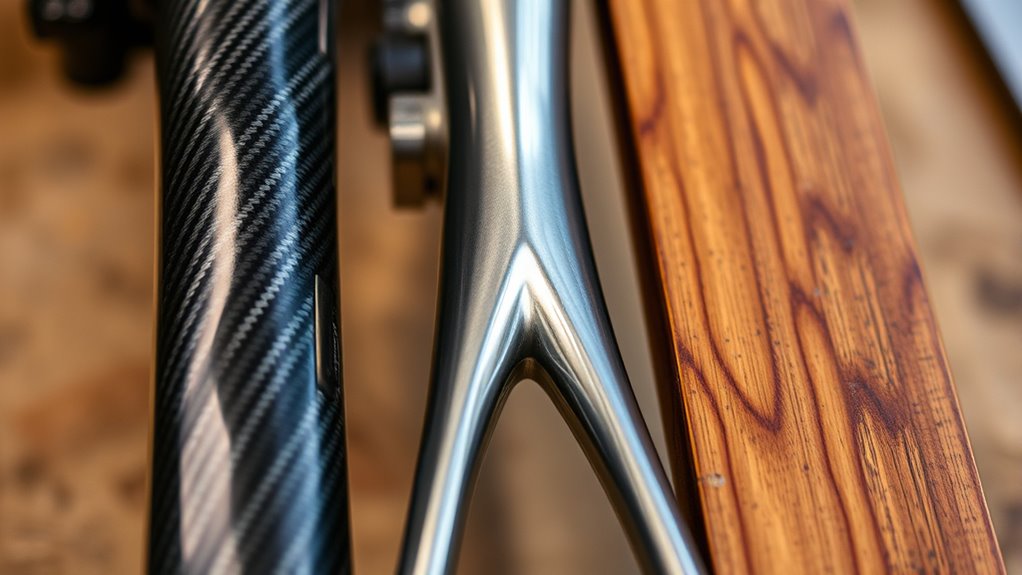
Understanding the key properties of frame materials is essential when choosing the right bicycle frame for your needs. Aluminum is lightweight, stiff, and affordable, making it popular for budget to mid-range bikes. It balances strength and weight well but isn’t as durable as steel over time. Symbols representing transformation and enlightenment can also inspire your choice of materials, emphasizing the importance of personal growth in your riding journey. Steel is heavier but highly durable, providing a comfortable ride with flexibility that’s ideal for touring or comfort bikes. Titanium combines corrosion resistance and durability, delivering a smooth ride similar to steel but at a higher cost. Each material’s alloys or mixtures are tailored to enhance specific properties, helping you choose based on your riding style and priorities.
Comparing Cost and Budget Considerations
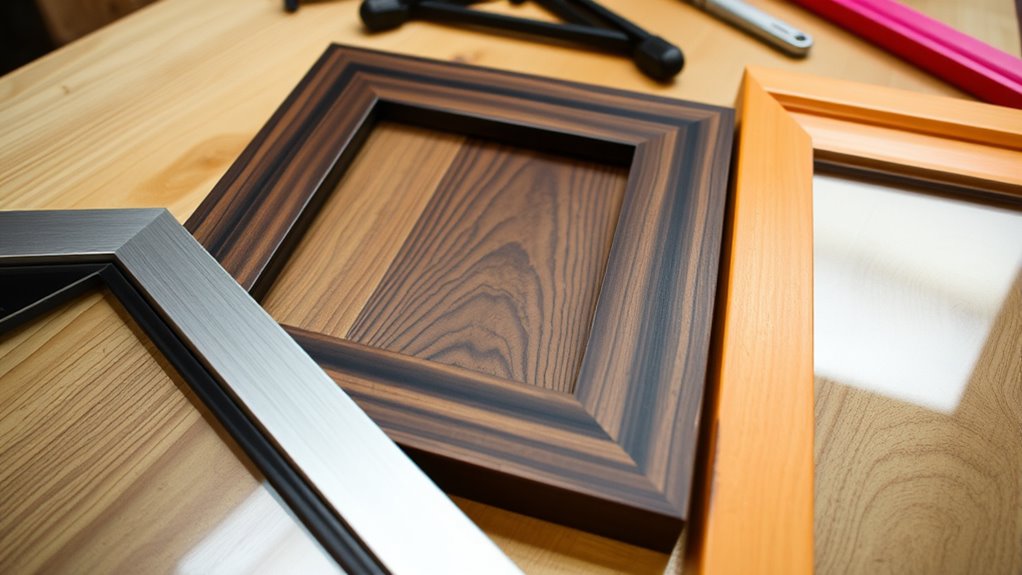
When comparing frame materials, cost is often a primary factor shaping your decision, but it’s important to contemplate both the upfront investment and long-term value. Carbon fiber and titanium come with high initial prices ($2,500–$4,000+), making them suitable for performance enthusiasts with bigger budgets. Aluminum offers the most affordable option ($500–$2,500), ideal for entry-level builds, but may require more frequent replacements. Steel strikes a balance, providing durability at a mid-range price, especially for touring or recreational riders. Keep in mind, materials like carbon fiber and titanium involve higher manufacturing costs, while aluminum benefits from standardized processes. Also, consider hidden costs, such as repair expenses for carbon fiber or rust prevention for steel, to make a well-rounded decision aligned with your long-term cycling goals. Additionally, understanding the long-term durability of each material can help you choose a frame that best suits your riding style and maintenance preferences. For example, corrosion resistance varies among materials and influences maintenance needs over time. Moreover, the compatibility of each material with different components and accessories can impact your overall build quality and upgrade potential. Incorporating leadership skills such as strategic planning and decision-making can also assist in evaluating which material offers the best overall value for your specific needs. Considering the weight of the frame material can also significantly affect your riding experience and performance.
Weighing Weight and Performance for Your Riding Style
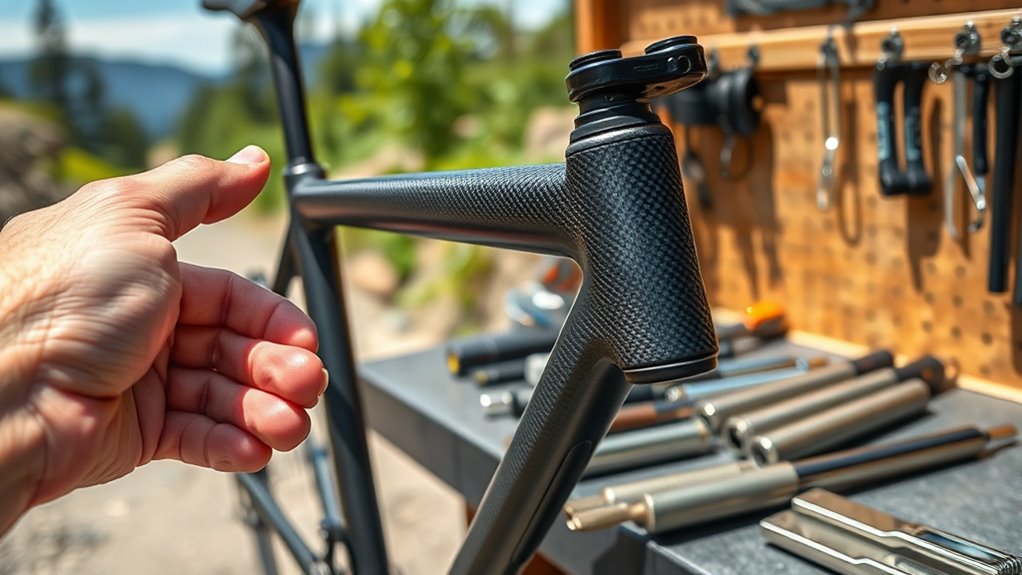
Choosing the right frame material depends heavily on your riding style and priorities for weight and performance.
If you want a lightweight option for efficiency, aluminum is a solid choice, offering a high stiffness-to-weight ratio without breaking the bank.
For top-tier performance and minimal weight, carbon fiber is ideal, providing strength and vibration damping, perfect for racing.
Steel and titanium frames are heavier but excel in shock absorption and long-term durability, making them suitable for endurance and touring rides.
Bamboo is a sustainable alternative, lighter than steel but less common.
Your choice should balance weight and performance based on terrain and riding goals.
For instance, mountain bikers prefer aluminum or carbon, while road racers favor carbon fiber for speed and responsiveness.
Durability and Long-Term Longevity of Different Materials
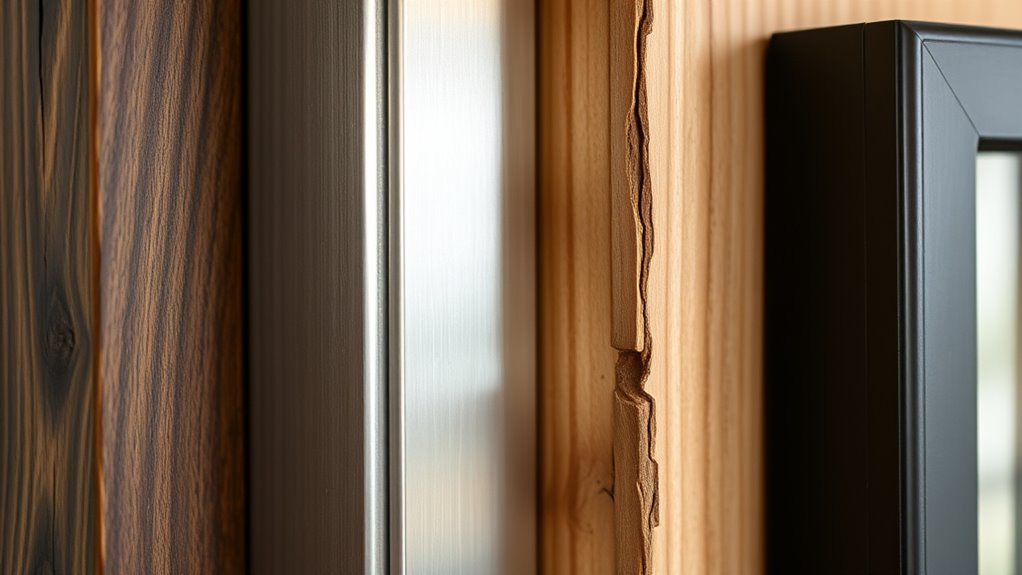
Durability and long-term longevity vary considerably among bike frame materials, influencing how well your ride holds up over time. Aluminum frames offer a good balance of strength and weight but are prone to fatigue, requiring regular inspections. Material fatigue is a critical factor to consider, as it can lead to unexpected failures if not properly monitored. Innovative planter designs demonstrate how material choices can impact longevity, emphasizing the importance of selecting durable options. Steel is more durable and can last many years if properly maintained to prevent rust. Titanium stands out as exceptionally durable and corrosion-resistant, often lasting a lifetime with minimal care. Chromoly steel provides strength and resistance to degradation, making it a long-lasting choice at a moderate cost. Carbon fiber, while lightweight and stiff, is less durable and susceptible to cracks from impacts or crashes, which can shorten its lifespan. Your choice depends on how much durability you need and how willing you’re to maintain your frame over the years.
Comfort and Shock Absorption Features
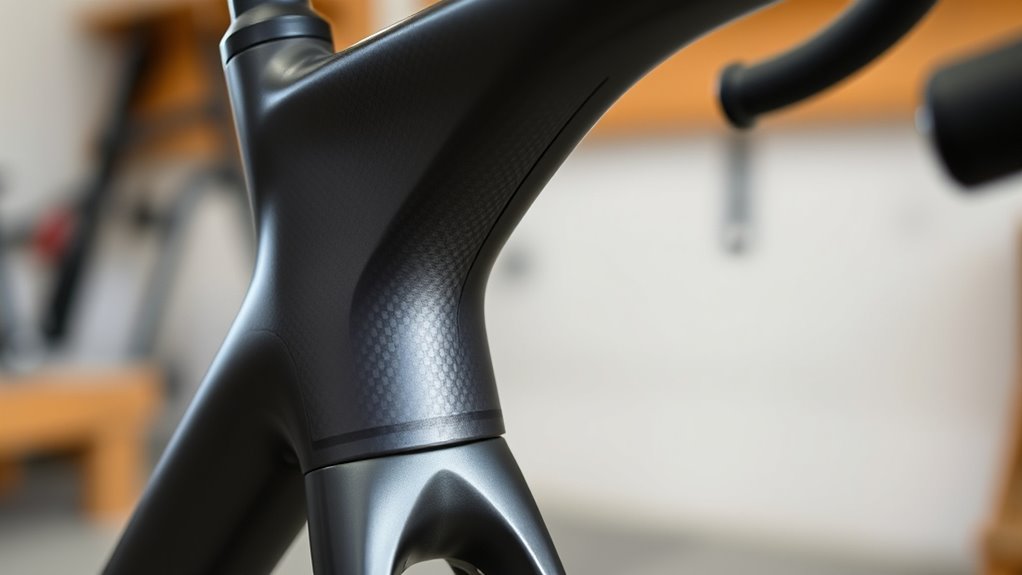
Different frame materials offer varying levels of comfort and shock absorption, directly impacting your ride quality. Carbon fibre effectively dampens high-frequency vibrations, reducing road chatter through material compliance and tunable zones. Additionally, Kia Tuning options can optimize suspension performance, further enhancing shock absorption. Steel naturally absorbs shocks via its inherent flex, providing a smooth, progressive ride, especially over long distances. Titanium combines the vibration damping of steel with a lightweight profile, returning to shape after impacts and offering a springy feel. Aluminum, while stiffer, transmits more road vibrations but can be softened with modern design features like wider tires or seatpost compliance. Custom layups in carbon allow targeted shock absorption, while design choices like tubing diameter and geometry influence vibration transmission. Incorporating advanced shock mitigation technologies can further improve ride comfort, regardless of frame material.
Resistance to Corrosion and Environmental Factors

When selecting a bike frame, understanding its resistance to corrosion and environmental factors is crucial for ensuring longevity and performance. Aluminum frames naturally form a protective oxide layer, making them resistant to corrosion, while titanium also resists corrosion well thanks to its natural oxide coating.
Choosing a corrosion-resistant bike frame is key for durability and performance.
Steel frames, however, are prone to rust unless properly coated or made from stainless steel. Carbon fiber doesn’t corrode but can be vulnerable to moisture and chemicals if not sealed properly.
Environmental factors like moisture, salt, and temperature extremes impact these materials differently. Titanium and aluminum handle moisture and salt better, making them ideal for coastal or humid areas.
Proper maintenance, such as applying coatings or regular inspections, helps extend the lifespan of your chosen frame.
Customization Potential and Aesthetic Appeal

Choosing the right frame material opens up a world of customization options and aesthetic possibilities that can truly reflect your personal style and riding preferences.
With steel, you can explore classic lugged construction and intricate pinstriping, perfect for vintage looks.
Aluminum allows for sleek, modern designs with anodized finishes and bold graphics.
Carbon fiber offers radical layering, custom color gradients, and unique weave patterns for a striking appearance.
Titanium showcases natural metal finishes like brushed or polished surfaces, making it ideal for a refined look.
Hybrids give you the flexibility to combine materials, blending performance traits.
Additionally, surface finishes such as matte coatings, metallic hues, or embedded decorative elements enable further personalization.
These options let you craft a bike that’s not only functional but also a true expression of your style.
Suitability for Various Terrains and Riding Conditions
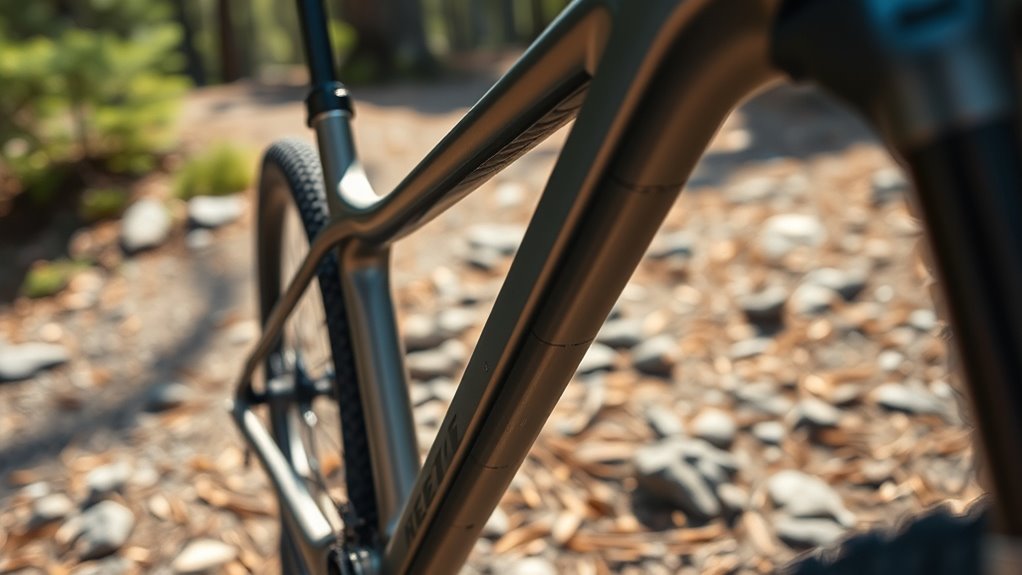
Selecting the right frame material depends heavily on the terrain you’ll ride and the conditions you’ll encounter.
Choosing the best bike frame material depends on your riding terrain and environmental conditions.
For paved roads, aluminum offers lightweight efficiency, while carbon fiber reduces road chatter, making long rides easier. Steel provides comfort with its natural flex, and titanium combines steel-like comfort with lighter weight, perfect for mixed terrains.
Gravel riding benefits from steel’s impact resistance and titanium’s corrosion resistance, while carbon fiber allows engineered compliance zones for uneven surfaces.
In mountain biking, carbon fiber handles aggressive trails, aluminum offers durability, and steel withstands impacts.
Urban rides favor steel for durability and aluminum for weight savings, with titanium resisting corrosion in all weather.
Consider environmental factors too—titanium resists rust, whereas aluminum needs protective treatments in salty environments.
Compatibility With Rider Weight and Physical Demands
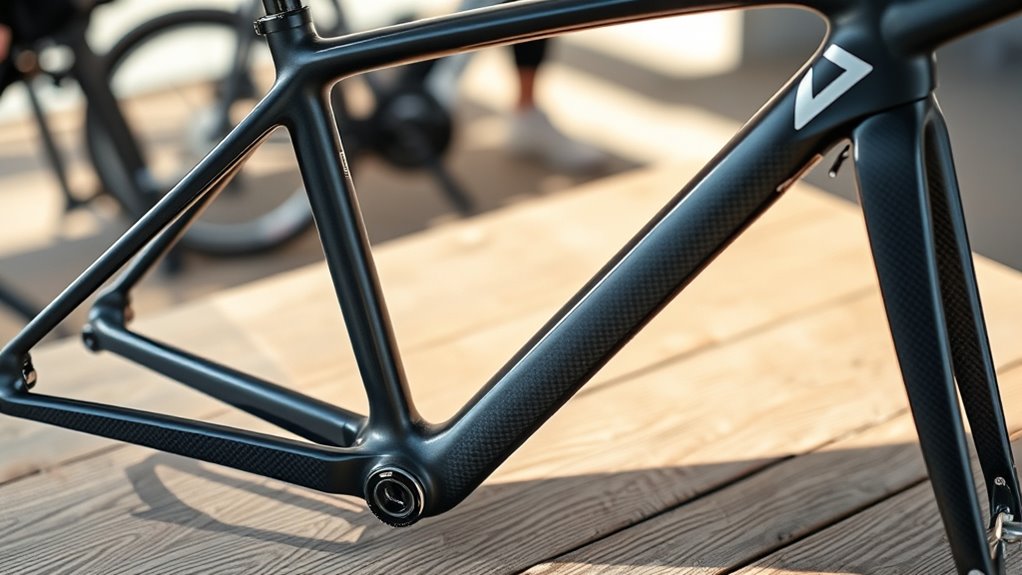
Your rider weight and physical demands play a crucial role in determining the best frame material. If you’re heavier, steel frames are a solid choice due to their high strength and durability, capable of handling increased stress.
Aluminium frames, while lightweight and strong, can fatigue faster under heavy loads or intense use, which may reduce longevity.
For those with high physical demands, carbon fiber frames offer excellent flexibility and shock absorption, easing stress on your body.
Titanium strikes a balance, providing strength without adding unnecessary weight, making it ideal for varied physical demands.
Additionally, frame design features like butting techniques and tailored tube thicknesses help reinforce strength where needed, ensuring your bike withstands your riding style and physical requirements confidently.
Making an Informed Choice Based on Lifestyle and Preferences

Understanding how your lifestyle and riding preferences influence the best frame material can help you make a more informed decision.
If you ride on rugged terrain or in diverse weather, materials like titanium or steel offer corrosion resistance and durability, making them reliable choices.
For long-distance touring, steel or titanium provide a smooth, comfortable ride, with steel’s repairability being a plus.
If speed and agility are priorities, racing enthusiasts should consider carbon fiber for its lightweight and aerodynamic benefits.
Budget also plays a role—aluminum is affordable and versatile, perfect for everyday riding.
Think about maintenance accessibility and how frequently you ride; durable materials like steel and titanium require less upkeep.
Matching your lifestyle to the material ensures your bike performs reliably and suits your riding habits.
Frequently Asked Questions
How Does Frame Material Impact Overall Bike Handling and Responsiveness?
Frame material directly influences your bike’s handling and responsiveness. For sharp steering and quick reactions, aluminum offers immediate power transfer and precise control.
Carbon allows for tailored compliance to improve cornering feel. Steel provides stable, predictable handling, and titanium offers a balanced ride.
Your choice depends on whether you prioritize quick responsiveness, stability, or comfort, as each material’s stiffness, damping, and flex patterns shape your overall riding experience.
What Maintenance Requirements Are Specific to Different Frame Materials?
You need to know that different frame materials demand specific maintenance. Steel frames require regular rust prevention, like applying rust inhibitors and keeping them dry, especially in humid or salty environments.
Aluminum needs cleaning with gentle methods and anti-seize on bolts to prevent corrosion.
Titanium and carbon fiber frames are low maintenance but benefit from occasional cleaning with bike-specific products and protective waxes to keep their finish pristine.
Are There Environmental Benefits Associated With Choosing Certain Frame Materials?
When you consider environmental benefits, choosing recycled steel over new aluminum can make a difference. For example, recycled steel reduces mining impact and energy use, lowering your bike’s carbon footprint.
How Does Frame Material Influence Resale Value and Bike Longevity?
Frame material substantially impacts your bike’s resale value and longevity. High-quality steel and titanium hold their value well due to craftsmanship and durability.
While carbon fiber frames tend to depreciate faster unless from elite brands. Steel and titanium also last decades with minimal maintenance.
However, aluminum frames may fatigue over time. Choosing a reputable brand and keeping documentation can boost resale, ensuring your bike remains a worthwhile investment in both value and lifespan.
Can Frame Material Choices Affect Compatibility With Other Bike Components?
When it comes to compatibility, your choice of frame material can make or break your build. You might think it’s just about aesthetics, but different materials require specific components or fittings.
For instance, carbon frames often need specialized bonding for mounts, while aluminum frames may need different headset or seatpost sizes. You need to keep your eyes open and choose materials that work seamlessly with your preferred components, so everything fits like a glove.
Conclusion
Choosing the right frame material is like planting a seed—you’ll want to nurture it with your riding style, budget, and terrain in mind. When you pick wisely, your bike becomes an extension of yourself, ready to blossom on every adventure. Trust your instincts and weigh each factor carefully, so your ride feels as natural as a breeze. With the right choice, your cycling journey will flourish and inspire you to go further than ever before.
















